Understanding the Importance of Slope Protection to Prevent Landslides and Ensure Mining Safety. Learn about structural and vegetative methods, as well as premium materials such as geotextile, geogrid, and shotcrete. Consult Aptekindo for safe and effective slope protection solutions today.
Why Do Slopes Need Protection?
What Is Slope Protection?
Slope protection refers to a series of methods and materials used to maintain the stability of soil or rock slopes, preventing erosion, landslides, and structural damage in mining and construction areas.
Its main purpose is to ensure workplace safety so that mining activities can operate smoothly without disruptions caused by soil movement. Slope protection is applied not only in open areas but also in underground mines, including internal slopes and access roads. With proper protection, the risks of workplace accidents and material losses can be significantly minimized.
The Importance of Slope Protection
- Ensuring Worker Safety: Unstable slopes can lead to landslides or collapses that endanger workers. Slope protection acts as a barrier or additional safeguard to reduce accident risks.
- Supporting Operational Efficiency: Soil movements or landslides can temporarily halt mining or construction operations. With slope protection, operations remain stable and uninterrupted, maintaining project productivity.
- Extending Infrastructure Lifespan: Protected slopes prevent erosion that could damage roads, tunnels, or mining support structures, helping to reduce future repair and maintenance costs.
- Reducing Environmental Impact: Landslides can harm nearby ecosystems. Slope protection helps maintain soil and water flow stability, minimizing environmental damage.
- Building Client and Stakeholder Trust: Implementing proper protection methods and materials demonstrates a strong commitment to safety and quality, enhancing the company’s professional reputation.
Understanding slope protection allows mining and construction companies to take preventive measures before risks escalate into serious problems. The right choice of methods and materials determines the success of slope protection and ensures safe, efficient, and sustainable operations.
Understanding Slope Fundamentals and Damage Risks
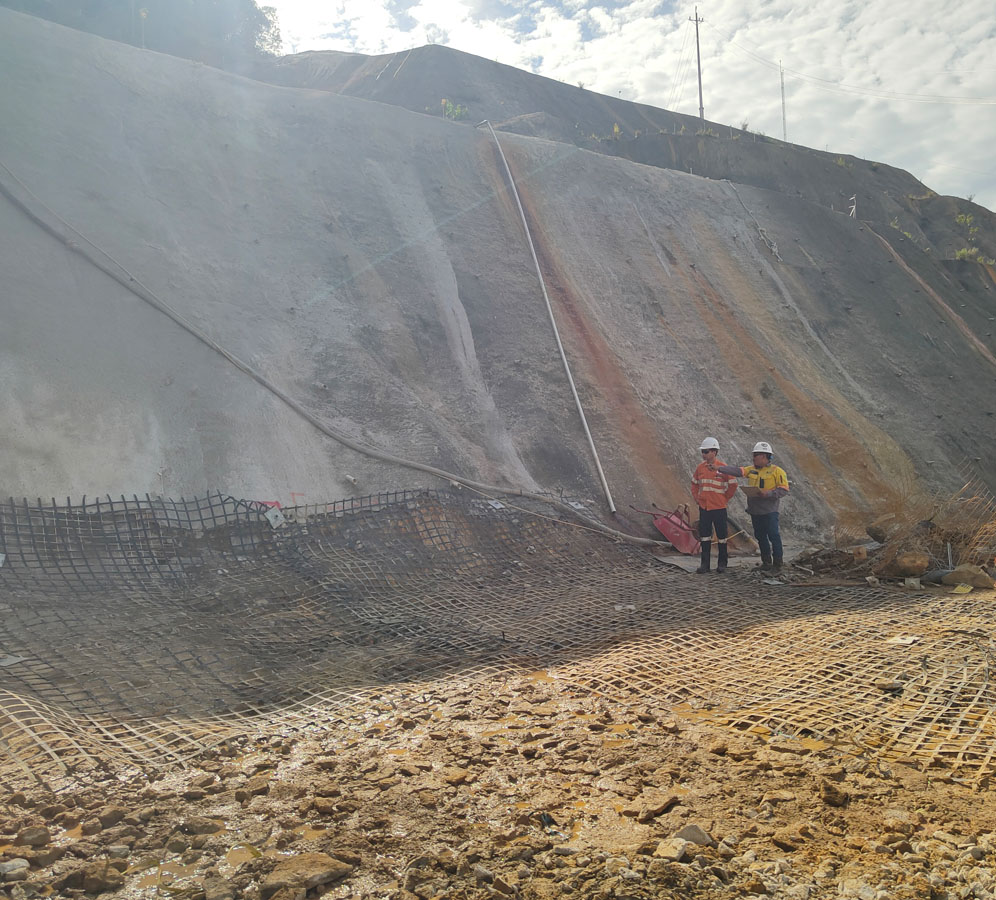
Slope Protection Basics: Key Factors Affecting Stability
Slope stability depends on geotechnical, environmental, and human factors. Key aspects include:
- Soil and Rock Conditions: Soil type, water content, and rock composition determine a slope’s resistance to pressure and erosion. Sandy or clay soils tend to shift more easily.
- Slope Angle: Steeper slopes face higher landslide risks. Proper analysis helps determine the appropriate protection method.
- Rainfall and Drainage: Uncontrolled water flow can cause erosion and soil movement. Efficient drainage systems reduce internal water pressure.
- Mining or Construction Activities: Excavation, earth cutting, and vibrations from heavy machinery can affect slope stability. Slope protection provides additional reinforcement.
- Vegetation: Plant roots help hold the soil, but when vegetation is sparse or damaged, the slope becomes more vulnerable.
Common Slope Failures Prevented by Geosynthetics
Modern slope protection especially using geosynthetic materials aims to prevent various types of slope failure:
- Shallow Surface Failures: Thin surface landslides caused by erosion, heavy rain, or minor disturbances. If left untreated, they can evolve into major problems.
- Rotational Failures: Slopes failing along a curved surface due to weak or unconsolidated soil, requiring structural reinforcement.
- Facing Instability: Surface instability caused by pressure from materials behind the slope. Without proper support such as shotcrete or high-quality geosynthetics, larger-scale collapses can occur.
Understanding these failure types is key to choosing the right slope protection strategy. With proper analysis and method selection, companies can reduce accidents, maintain productivity, and ensure safety.
Key Materials Used in Slope Protection
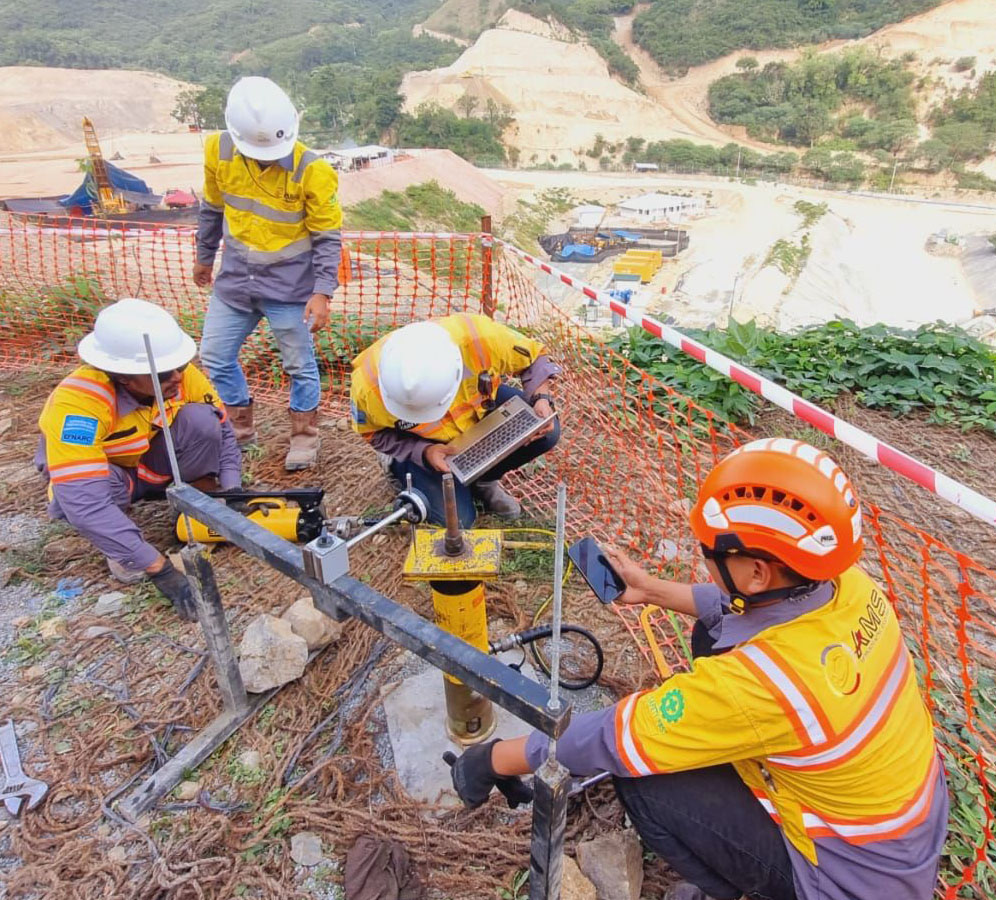
Choosing the right materials is essential for maintaining slope stability and preventing landslides. Common materials include:
- Geotextile: A polymer-based fabric that reinforces slopes, prevents erosion, and controls water flow. It acts as both a separator and stabilizer, extending infrastructure lifespan.
- Geogrid: A grid-like structure that distributes loads evenly and strengthens soil. When combined with geotextile or soil cover layers, it provides long-term protection against sliding.
- Geomat: A 3D synthetic layer that supports vegetation and prevents erosion. Its porous structure allows roots to grow and bind soil naturally, offering an eco-friendly protection method.
- Shotcrete: Sprayed concrete that forms a dense, durable protective layer. It strengthens steep or rocky slopes and enhances drainage systems. When combined with geosynthetics, it provides dual-layer protection.
Selecting the proper combination of materials and methods ensures safe, efficient, and long-lasting slope stability. Aptekindo offers top-quality materials tailored to project needs, ensuring safety and operational success.
Effective Methods for Slope Protection
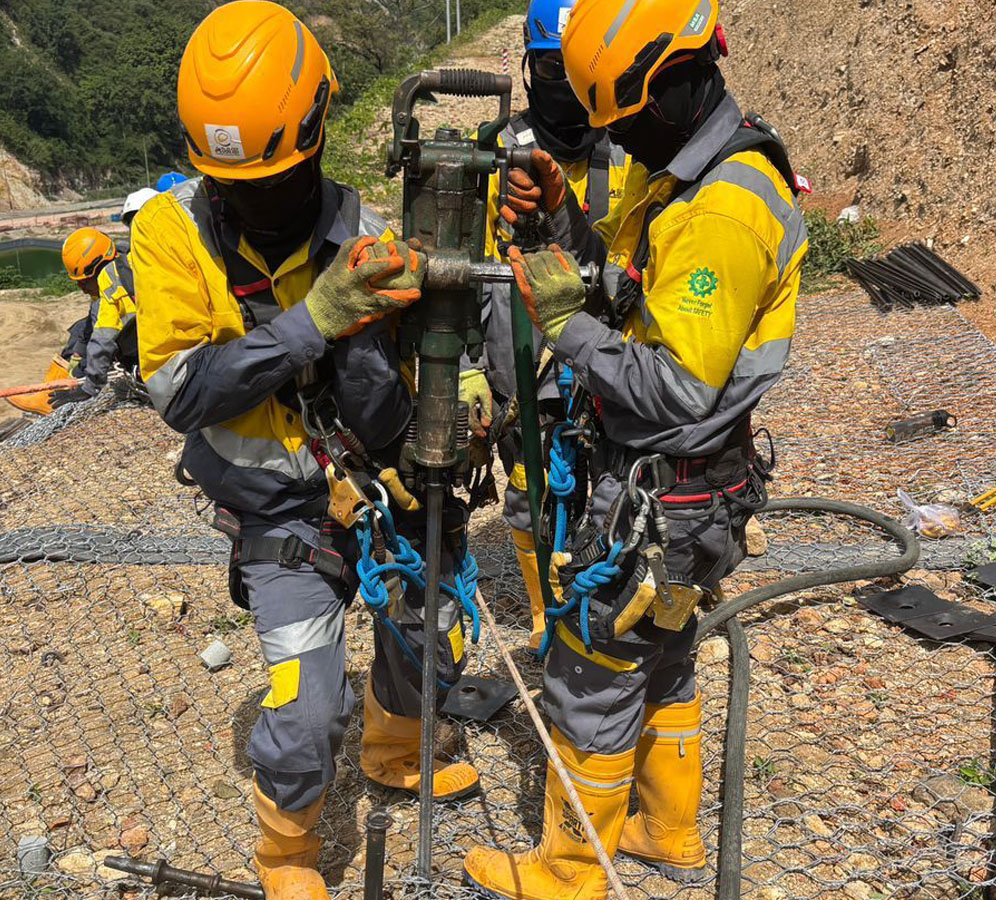
Selecting the right protection method is crucial for stability and safety in mining or construction zones. Common methods include:
1. Structural Measures
These involve engineering materials and systems to reinforce slopes and prevent landslides.
- Drainage Systems with Geotextile: Improve water flow, prevent pressure buildup, and strengthen soil.
- Non-Perforated Geocell: A cell-structured system filled with soil or aggregate that distributes load and increases slope strength ideal for steep or high-pressure areas.
2. Vegetative & Bioengineering Methods
Using plants and natural materials to stabilize slopes and control erosion.
- Bioengineering Techniques: Combine vegetation and simple structures for long-term, eco-friendly slope stability.
- Hydroseeding: Spraying a mixture of seeds, fertilizer, and erosion-control material for quick vegetation growth.
- Erosion Control Blankets: Natural or synthetic layers that protect soil from rain and wind while supporting plant growth.
- Taplok Method: Combines mechanical restraints and vegetation, ideal for steep or hard-to-access slopes.
Integrating structural and vegetative methods often yields the best results creating durable, eco-friendly, and efficient slope protection systems. Aptekindo provides high-quality materials and practical solutions for every method to ensure safe, efficient, and landslide-free operations.
Case Study: Aptekindo Slope Protection Project
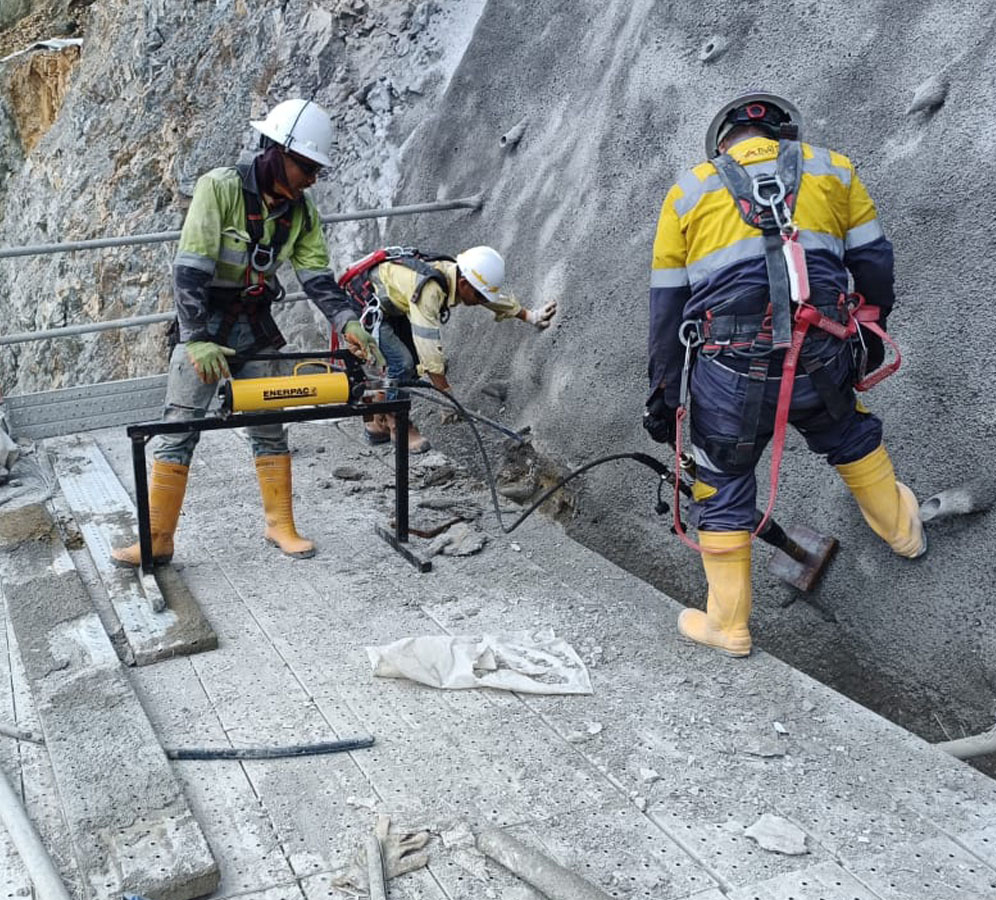
One notable example of Aptekindo’s expertise is the project for PT Tambang Tondano Nusajaya, supporting the new batching plant for underground development at Toka Tindung. This project demonstrates Aptekindo’s comprehensive approach from structural design to operational safety and quality control.
Key highlights include:
- Structural Design & Construction: Replacing the old batching plant with a more efficient steel structure to enhance concrete production capacity while supporting nearby slope stability.
- Operations & Skilled Personnel: Aptekindo provides trained staff for daily operations and maintenance, ensuring compliance with safety and quality standards.
- High-Quality Admixtures: Supplying superplasticizers, accelerators, retarders, silica fume, and fibers to optimize shotcrete and structural concrete performance.
- Quality Control: Each concrete batch undergoes strict quality supervision to ensure consistency and reliability, contributing to slope stability and underground project success.
This project exemplifies Aptekindo’s integrated slope protection solutions from design and materials to operational excellence enhancing both safety and client trust.
Choosing the Right Slope Protection Solution
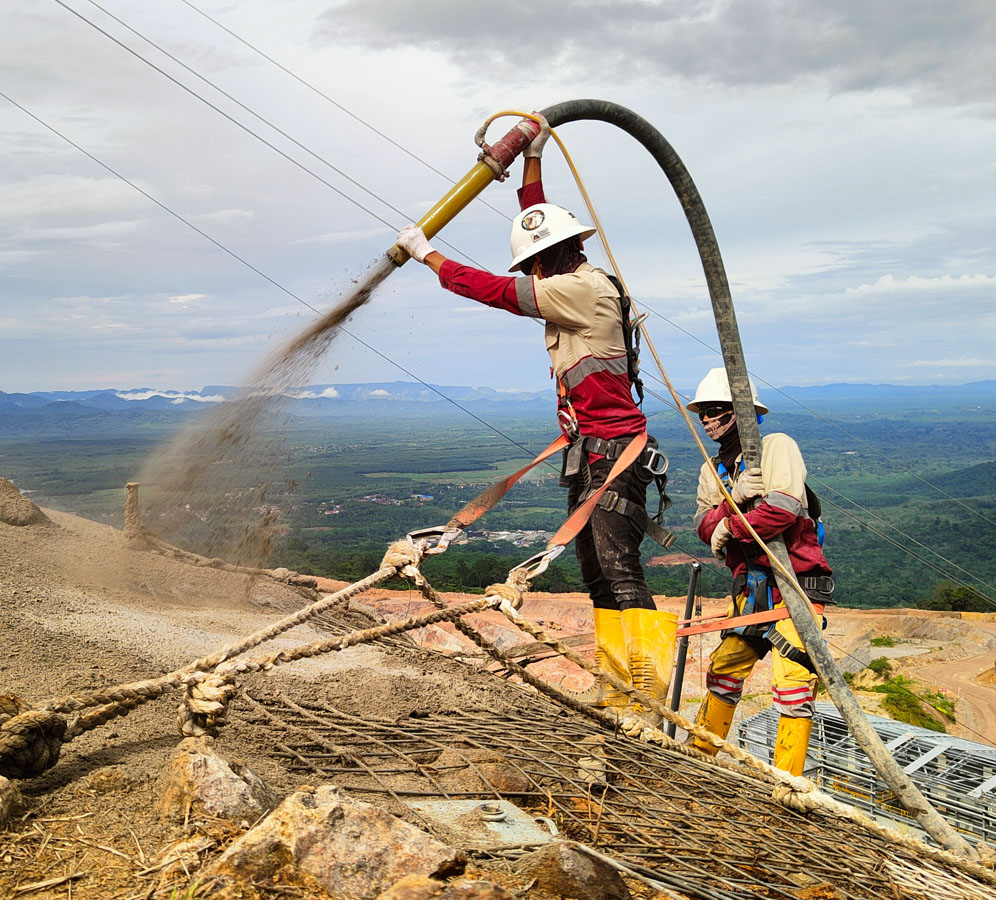
Ensuring slope stability and safety requires an accurate, site-specific approach. Before deciding on protection methods, conduct a detailed assessment of soil conditions, slope angle, rainfall patterns, and operational activities. The most effective slope protection integrates structural systems, vegetative reinforcement, and premium materials for maximum safety and longevity.
With the right strategy, slopes become more resistant to water pressure, soil movement, and extreme conditions while improving efficiency and reducing long-term maintenance costs.
Aptekindo stands as your trusted partner for reliable slope protection solutions. Their geotechnical experts provide tailored analysis and design services, supported by high-quality materials and proven field experience, ensuring stability and safety for your project.
Contact Aptekindo
- Instagram: @aptekindo
- Engineering Email: engineering@aptekindo.com
- Sales Email: sales@aptekindo.com
- LinkedIn: APTEKINDO
- YouTube: @anggunpermaitekindo-APT
Take proactive steps today protect your project with Aptekindo best slope protection solutions, ensuring safety, efficiency, and peace of mind for your entire team and stakeholders.




